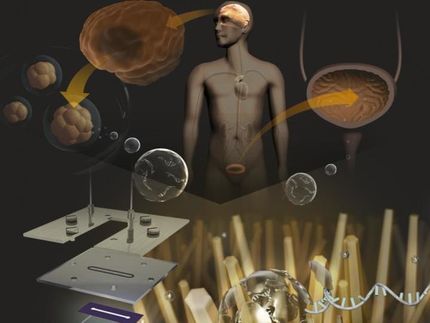Biomarker helps predict survival time in gastric cancer patients
gastric cancer poses a significant health problem in developing countries and is typically associated with late-stage diagnosis and high mortality. A new study in The American Journal of Pathology points to a pivotal role played by the biomarker microRNA (miR)-506 in gastric cancer. Patients whose primary gastric cancer lesions express high levels of miR-506 have significantly longer survival times compared to patients with low miR-506 expression. In addition, miR-506 suppresses tumor growth, blood vessel formation, and metastasis.
"Epithelial-to-mesenchymal transition (EMT) is an important process that enables cancer cells to invade their surroundings and to metastasize," explained lead investigator Xin Song, MD, PhD, of the Cancer Research Institute of Southern Medical University. "Our study presents evidence that miR-506 is a potent inhibitor of EMT."
Mesenchymal cells play an important role in normal tissue repair as well as in pathological processes such as tissue fibrosis, tumor growth, and cancer metastasis. Polarized epithelial cells undergo biochemical changes to give rise to mesenchymal cells through EMT. The transformed cells have the ability to migrate away from the epithelial layer, invade other tissues, and resist apoptosis. EMT is a key step during normal embryogenesis, but it is also now recognized to be involved in cancer pathophysiology. Changes in the expression of specific microRNAs, a class of small noncoding RNAs that regulate gene expression, are one of several mechanisms that may initiate an EMT.
Researchers examined the expression of one of these microRNAs, miR-506, which was in turn identified as a useful marker for stratifying gastric cancer patients. The researchers used quantitative real-time PCR in a blinded manner to detect miR-506 in human gastric cancer samples taken from 84 patients who had undergone cancer surgery. When samples were divided into groups with miR-506 levels above and below the mean, survival was found to be significantly longer in patients with high miR-506 expression. For example, at 60 months, cumulative survival was approximately 80% in the high miR-506 expression group compared to approximately 30% in the low-expression group.
The investigators next examined miR-506 expression in cells from seven gastric cancer cell lines. They found that gastric cancer cells had lower levels of miR-506 than normal stomach tissue. Further analysis of cell growth in vitro showed that miR-506 levels were lowest in the cell lines that had the highest invasive activity (SGC-7901 cells), and the highest levels were seen in cell lines with the lowest invasive activity (BGC-823 cells), thus supporting the hypothesis that miR-506 acts as a suppressor of cell metastasis. Lending greater strength to this hypothesis, inhibitors of miR-506 counteracted the downstream activity of miR-506, such as increasing the invasiveness and mobility of BGC-823 cells.
Further experiments showed that miR-506 inhibits angiogenesis, with miR-506 overexpression suppressing vascular tubule development in SGC-7901 cells and miR-506 inhibitors promoting the formation of a tubular vessel network in BGC-823 cells. They also showed that miR-506 overexpression was associated with decreased expression of matrix metalloproteinase-9 and -2, and provided evidence that miR-506 may be targeting the proto-oncogene ETS1. "These findings indicate that miR-506 is necessary and sufficient for angiogenesis suppression during gastric cancer progression," commented Dr. Song.
"In summary, cancer is a complex disease and controlling cancer development and progression requires system level and integrative approaches. Our study suggests that miR-506 acts as a tumor suppressor in gastric cancer. Additional studies will be needed to explore the potential clinical utility of miR-506 as a potential biomarker for gastric cancer prognosis and as a new potential therapeutic target," added Dr. Song.
Most read news

Get the analytics and lab tech industry in your inbox
By submitting this form you agree that LUMITOS AG will send you the newsletter(s) selected above by email. Your data will not be passed on to third parties. Your data will be stored and processed in accordance with our data protection regulations. LUMITOS may contact you by email for the purpose of advertising or market and opinion surveys. You can revoke your consent at any time without giving reasons to LUMITOS AG, Ernst-Augustin-Str. 2, 12489 Berlin, Germany or by e-mail at revoke@lumitos.com with effect for the future. In addition, each email contains a link to unsubscribe from the corresponding newsletter.
























































